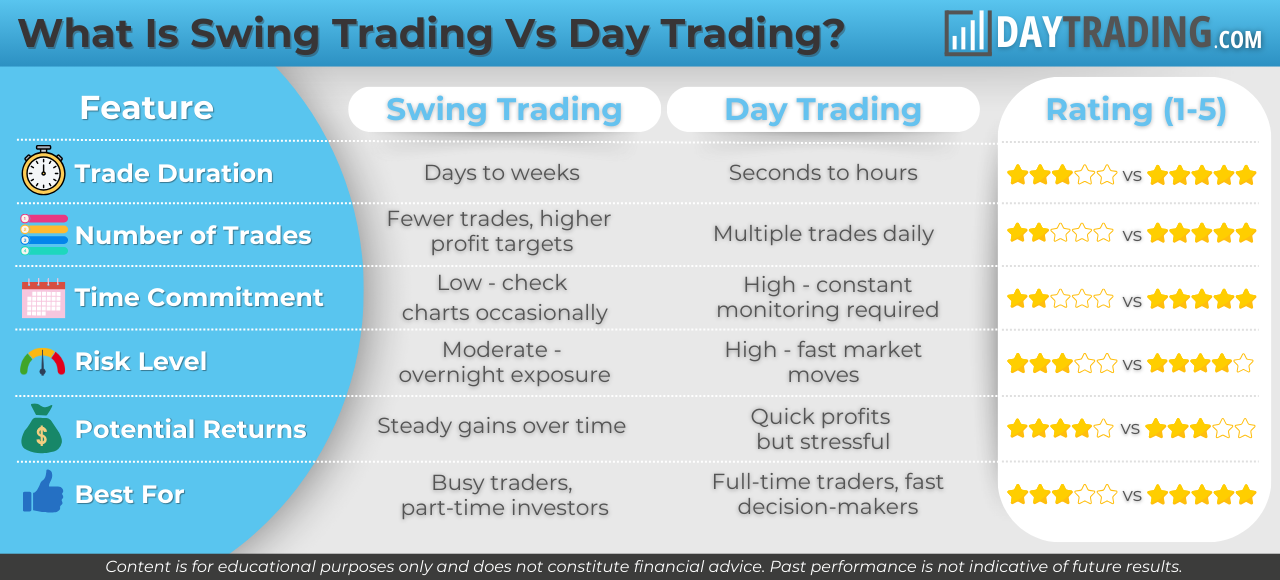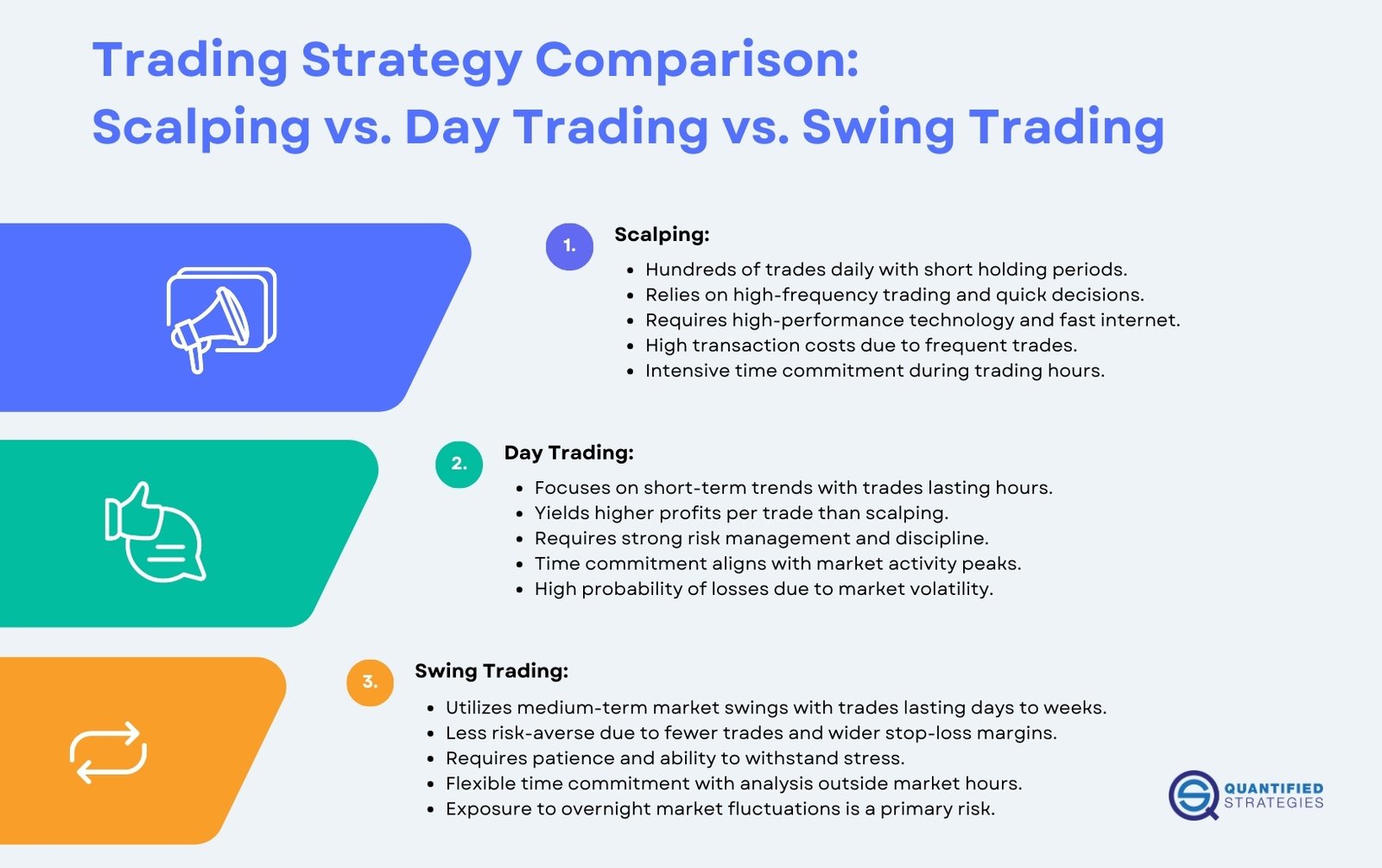Swing Trading vs. Day Trading in Forex – Which One Works Best?
If you’re stepping into the world of forex trading, one of the first big decisions you’ll face is choosing your trading style. Two of the most popular strategies are swing trading and day trading—each with its own pace, risk profile, and potential for profit. But which one is actually better?
Well, the answer really depends on your personality, time commitment, and trading goals. In this guide, we’ll break down the key differences between swing trading and day trading in forex, the pros and cons of each, and how to figure out which one might work best for you.

What Is Swing Trading in Forex?
Swing trading is all about holding onto trades for several days or even weeks. Instead of trying to capture small price movements throughout the day, swing traders look for bigger price swings over a medium-term period.
How It Works:
- Swing traders analyze both technical and fundamental indicators.
- They often rely on daily or 4-hour charts to spot trends or reversal patterns.
- Trades can last anywhere from a few days to a couple of weeks.
- Stop-loss and take-profit levels are typically wider to account for volatility.
The main idea is to catch “swings” in the market—those moments when prices change direction and move significantly in one direction before reversing again.
What Is Day Trading in Forex?

Day trading, on the other hand, is all about opening and closing trades within the same day. You’re not looking to hold anything overnight. Day traders aim to profit from small price movements by making multiple trades in a single day.
How It Works:
- Day traders often use short-term charts like the 5-minute or 15-minute charts.
- They rely heavily on technical indicators like moving averages, MACD, RSI, and volume.
- Positions are opened and closed quickly—sometimes within minutes.
- There’s no overnight risk since trades are closed before the end of the trading session.
The key goal? Make small but consistent profits that add up over time.
Key Differences Between Swing and Day Trading
Here’s a side-by-side comparison to make things easier:
| Feature | Swing Trading | Day Trading |
|---|---|---|
| Timeframe | Days to weeks | Intraday (minutes to hours) |
| Trade Frequency | Low to moderate | High |
| Chart Types | 4-hour, daily, weekly | 1-min, 5-min, 15-min |
| Risk Exposure | Overnight/weekend risk | No overnight risk |
| Time Commitment | A few hours a week | Several hours per day |
| Required Skill | Patience, trend analysis | Fast decision-making, scalping |
| Stress Level | Lower (less screen time) | Higher (constant monitoring) |
| Potential Returns | Moderate, but can be high | Can be high, but requires consistency |
Pros and Cons of Swing Trading
✅ Pros:
- Less screen time – Ideal for part-time traders or those with full-time jobs.
- Fewer trades – You make fewer decisions, which reduces the risk of emotional mistakes.
- Captures larger moves – By holding trades longer, you can profit from bigger price swings.
- Lower transaction costs – Fewer trades mean fewer spreads and fees.
❌ Cons:
- Overnight risk – News events, political drama, or surprise economic reports can shake the market while you’re sleeping.
- Slower results – You won’t see profits (or losses) as quickly as a day trader.
- Requires patience – Trades can take days or weeks to play out, which isn’t ideal if you like fast action.
Pros and Cons of Day Trading

✅ Pros:
- Quick results – You’ll know by the end of the day whether you’re in profit or not.
- No overnight exposure – You avoid gaps caused by overnight or weekend news.
- Plenty of opportunities – Forex markets are super liquid, so there’s always action.
❌ Cons:
- Time-consuming – You need to be glued to the screen during trading hours.
- Emotionally intense – The constant action and quick decisions can be stressful.
- Higher transaction costs – Multiple trades a day means paying more in spreads and commissions.
- Steeper learning curve – Mastering technical indicators and scalp techniques takes time.
Which Style Is Best for You?
Now comes the million-dollar question: Should you swing trade or day trade?
Here’s a breakdown based on different trader types:
Swing Trading Might Be Best If You:
- Have a full-time job or other major time commitments
- Prefer a slower, more analytical trading approach
- Are okay with holding positions overnight
- Don’t want to sit in front of the screen all day
- Are more emotionally balanced and patient
Day Trading Might Be Best If You:

- Can dedicate several hours a day to the market
- Thrive under pressure and love fast-paced decisions
- Want daily trading action and immediate feedback
- Don’t mind a higher-stress environment
- Have solid risk management and quick reflexes
Advanced Tips for Both Styles
No matter which trading style you choose, these tips can help you succeed:
✅ For Swing Traders:
- Use wide stop-loss levels to accommodate volatility.
- Follow macroeconomic news to understand bigger trends.
- Combine technical and fundamental analysis for better entries.
- Keep a trading journal to track patterns over time.
✅ For Day Traders:
- Start with one or two currency pairs to avoid overwhelm.
- Practice discipline—don’t force trades when conditions aren’t ideal.
- Stick to a daily profit/loss limit to protect your capital.
- Use demo accounts before going live to master your strategy.
Common Mistakes to Avoid
Here are a few traps that many traders—beginners especially—fall into:
- Overtrading: Whether you’re day trading or swing trading, taking too many trades can eat into profits.
- Ignoring the news: Even technical traders need to know when major announcements are happening.
- Poor risk management: Always use a stop-loss and never risk more than 1–2% of your capital per trade.
- Chasing losses: Losing trades happen. Don’t let emotions lead you to revenge-trade.
FAQs: Swing Trading vs. Day Trading
Is swing trading safer than day trading?
Not necessarily. Swing trading avoids the stress of quick decisions but carries overnight risk. Both styles can be risky without solid strategy and discipline.
Can I do both day trading and swing trading?
Yes, some traders use a hybrid approach, swing trading the major trends and day trading smaller moves. Just make sure you don’t get overwhelmed.
Which is more profitable: swing or day trading?
Both can be profitable. Day trading offers more frequent opportunities, while swing trading may yield higher profit per trade. Your success depends more on strategy, psychology, and discipline than the style you choose.
Do I need a lot of money to start?
Not really. Thanks to leverage in forex, you can start small. However, more capital gives you more flexibility, especially in swing trading.
What tools do I need to start?
A good trading platform, a solid internet connection, charting software (like MetaTrader or TradingView), and a reliable broker. Plus, lots of practice and a written strategy.
Final Thoughts: So, Which One Works Best?
There’s no one-size-fits-all answer when it comes to swing trading vs. day trading in forex. Each style has its strengths and weaknesses. The best one for you depends on your personality, schedule, and risk tolerance.
If you like analyzing charts in the evening and letting your trades ride, swing trading could be your sweet spot. But if you thrive on quick decisions and love a fast-paced environment, day trading might be more your style.
Whichever path you choose, remember: Consistency, discipline, and proper risk management are far more important than the strategy itself. Choose a style that fits your lifestyle, stick with it, and keep learning.






